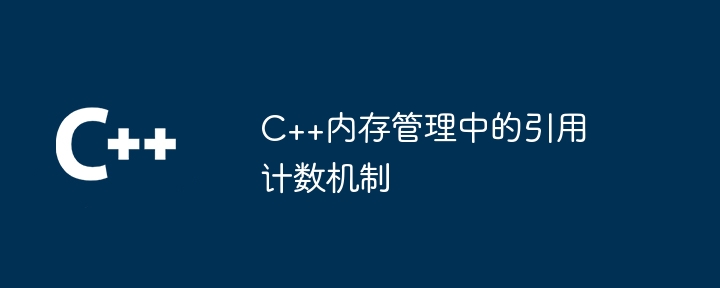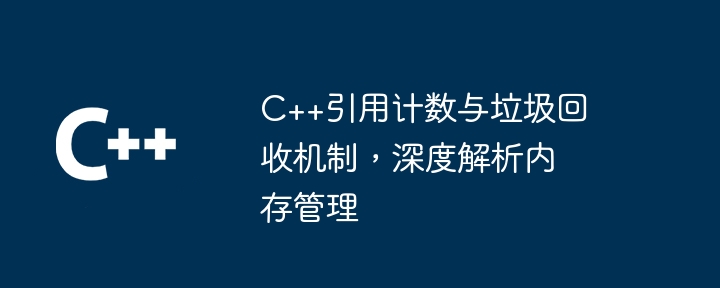 Backend Development
Backend Development C++
C++ C++ reference counting and garbage collection mechanism, in-depth analysis of memory management
C++ reference counting and garbage collection mechanism, in-depth analysis of memory managementIn C++, reference counting is a memory management technique. When an object is no longer referenced, the reference count will be zero and can be safely released. Garbage collection is a technique that automatically releases memory that is no longer in use. The garbage collector periodically scans and releases dangling objects. Smart pointers are C++ classes that automatically manage the memory of the object they point to, keeping track of reference counts and freeing the memory when it is no longer referenced.

C++ reference counting and garbage collection mechanism, in-depth analysis of memory management
Introduction
Managing memory in C++ is a crucial task. Programmers must allocate and free memory manually, otherwise problems such as memory leaks or dangling pointers can result. This article will take an in-depth look at the reference counting and garbage collection mechanisms in C++ and demonstrate how they work through practical examples.
Reference Counting
Reference counting is a memory management technique that tracks the number of times each object is referenced (holds a reference). When an object is no longer referenced, its reference count will be zero and it can be safely released.
Basic Principle
- Every object is associated with a reference count.
- When an object is created, its reference count is initialized to 1.
- When an object is referenced by another object, the reference count of the referencing object is incremented.
- When an object is no longer referenced by any object, its reference count is decremented.
- When the object's reference count reaches 0, it will be automatically released.
Example
#include <iostream>
class Test {
public:
Test() { std::cout << "Test constructor\n"; }
~Test() { std::cout << "Test destructor\n"; }
};
int main() {
Test* obj1 = new Test; // 引用计数 = 1
Test* obj2 = obj1; // 引用计数 = 2
delete obj1; // 引用计数 = 1 (删除 obj1 但 obj2 仍然引用)
delete obj2; // 引用计数 = 0 (删除 obj2,内存释放)
return 0;
}Garbage collection
Garbage collection is a memory management technology that automatically releases memory that is being used again. In garbage collection, the programmer does not have to free memory manually.
Basic Principle
- The garbage collector scans all objects periodically.
- The garbage collector identifies and marks objects that are no longer in use (dangling objects).
- The garbage collector releases objects marked as dangling.
Example
Some programming languages, such as Java and Python, use garbage collection to manage memory. Examples are as follows:
class Test:
def __init__(self):
print("Test constructor")
def __del__(self):
print("Test destructor")
obj1 = Test() # 创建对象
obj2 = obj1 # 引用对象
# 当 obj1 和 obj2 都不再引用对象时,垃圾收集器将自动释放对象Practical case: smart pointer
A smart pointer is a C++ class that can automatically manage the memory of the object it points to. Smart pointers track an object's reference count and automatically release memory when the object is no longer referenced.
Example
#include <memory>
class Test {
public:
Test() { std::cout << "Test constructor\n"; }
~Test() { std::cout << "Test destructor\n"; }
};
int main() {
// 使用 std::unique_ptr 管理 Test 对象
std::unique_ptr<Test> obj = std::make_unique<Test>();
// 当 obj 离开作用域时,Test 对象将被自动释放
return 0;
}Conclusion
Reference counting and garbage collection are two important techniques for managing memory in C++ . Reference counting allows programmers to manually manage memory, while garbage collection automatically releases memory that is no longer used. Smart pointers provide a convenient and safe alternative to using reference counting for memory management. By understanding these techniques, programmers can manage memory efficiently, thereby preventing problems such as memory leaks and dangling pointers.
The above is the detailed content of C++ reference counting and garbage collection mechanism, in-depth analysis of memory management. For more information, please follow other related articles on the PHP Chinese website!
 C#开发中如何避免内存泄漏Oct 08, 2023 am 09:36 AM
C#开发中如何避免内存泄漏Oct 08, 2023 am 09:36 AMC#开发中如何避免内存泄漏,需要具体代码示例内存泄漏是软件开发过程中常见的问题之一,特别是在使用C#语言进行开发时。内存泄漏会导致应用程序占用越来越多的内存空间,最终导致程序运行缓慢甚至崩溃。为了避免内存泄漏,我们需要注意一些常见的问题并采取相应措施。及时释放资源在C#中,使用完资源后一定要及时释放它们,尤其是涉及到文件操作、数据库连接和网络请求等资源。可以
 PHP中的内存管理和垃圾回收技术May 11, 2023 am 08:33 AM
PHP中的内存管理和垃圾回收技术May 11, 2023 am 08:33 AMPHP作为一种广泛使用的脚本语言,为了在运行时保证高效执行,具有独特的内存管理和垃圾回收技术。本文将简单介绍PHP内存管理和垃圾回收的原理和实现方式。一、PHP内存管理的原理PHP的内存管理采用了引用计数(ReferenceCounting)来实现,这种方式是现代化的语言中比较常见的内存管理方式之一。当一个变量被使用时,PHP会为其分配一段内存,并将这段内
 C++内存管理中的引用计数机制Jun 01, 2024 pm 08:07 PM
C++内存管理中的引用计数机制Jun 01, 2024 pm 08:07 PM引用计数机制在C++内存管理中用于跟踪对象的引用情况并自动释放未使用内存。该技术为每个对象维护一个引用计数器,当引用新增或移除时计数器相应增减。当计数器降为0时,对象被释放,无需手动管理。但循环引用会导致内存泄漏,且维护引用计数器会增加开销。
 Java开发中如何解决堆内存空间不足问题Jun 29, 2023 am 11:11 AM
Java开发中如何解决堆内存空间不足问题Jun 29, 2023 am 11:11 AMJava作为一门广泛使用的编程语言,由于其自动内存管理机制,特别是垃圾回收机制的存在,使得开发人员无需过多关注内存的分配和释放。然而,在一些特殊情况下,例如处理大数据或者运行复杂的算法时,Java程序可能会遇到堆内存空间不足的问题。本文将讨论如何解决这个问题。一、了解堆内存空间堆内存是Java虚拟机(JVM)中分配给Java程序运行时使用的内存空间。它存储了
 Java开发中如何避免网络连接泄露?Jun 30, 2023 pm 01:33 PM
Java开发中如何避免网络连接泄露?Jun 30, 2023 pm 01:33 PM如何解决Java开发中的网络连接泄露问题随着信息技术的高速发展,网络连接在Java开发中变得越来越重要。然而,Java开发中的网络连接泄露问题也逐渐凸显出来。网络连接泄露会导致系统性能下降、资源浪费以及系统崩溃等问题,因此解决网络连接泄露问题变得至关重要。网络连接泄露是指在Java开发中未正确关闭网络连接,导致连接资源无法释放,从而使系统无法正常工作。解决网
 go语言有垃圾回收吗Dec 09, 2022 pm 07:42 PM
go语言有垃圾回收吗Dec 09, 2022 pm 07:42 PMgo语言有垃圾回收。Go语言自带垃圾回收机制(GC);GC通过独立的进程执行,它会搜索不再使用的变量,并将其释放。在计算中。内存空间包含两个重要的区域:栈区 (Stack) 和堆区 (Heap);栈区一般存储了函数调用的参数、返回值以及局部变量,不会产生内存碎片,由编译器管理,无需开发者管理;而堆区会产生内存碎片,在Go语言中堆区的对象由内存分配器分配并由垃圾收集器回收。
 如何使用Go语言进行内存优化与垃圾回收Sep 29, 2023 pm 05:37 PM
如何使用Go语言进行内存优化与垃圾回收Sep 29, 2023 pm 05:37 PM如何使用Go语言进行内存优化与垃圾回收Go语言作为一门高性能、并发、效率高的编程语言,对于内存的优化和垃圾回收有着很好的支持。在开发Go程序时,合理地管理和优化内存使用,能够提高程序的性能和可靠性。使用合适的数据结构在Go语言中,选择合适的数据结构对内存的使用有很大的影响。例如,对于需要频繁添加和删除元素的集合,使用链表代替数组可以减少内存碎片的产生。另外,
 C++引用计数与垃圾回收机制,深度解析内存管理Jun 04, 2024 pm 08:36 PM
C++引用计数与垃圾回收机制,深度解析内存管理Jun 04, 2024 pm 08:36 PM在C++中,引用计数是一种内存管理技术,当对象不再被引用时,引用计数将为零,可安全释放。垃圾回收是一种自动释放不再使用的内存的技术,垃圾收集器会定期扫描并释放悬垂对象。智能指针是C++类,可自动管理所指向对象的内存,跟踪引用计数并在不再引用时释放内存。


Hot AI Tools

Undresser.AI Undress
AI-powered app for creating realistic nude photos

AI Clothes Remover
Online AI tool for removing clothes from photos.

Undress AI Tool
Undress images for free

Clothoff.io
AI clothes remover

AI Hentai Generator
Generate AI Hentai for free.

Hot Article

Hot Tools

Zend Studio 13.0.1
Powerful PHP integrated development environment

mPDF
mPDF is a PHP library that can generate PDF files from UTF-8 encoded HTML. The original author, Ian Back, wrote mPDF to output PDF files "on the fly" from his website and handle different languages. It is slower than original scripts like HTML2FPDF and produces larger files when using Unicode fonts, but supports CSS styles etc. and has a lot of enhancements. Supports almost all languages, including RTL (Arabic and Hebrew) and CJK (Chinese, Japanese and Korean). Supports nested block-level elements (such as P, DIV),

Notepad++7.3.1
Easy-to-use and free code editor

ZendStudio 13.5.1 Mac
Powerful PHP integrated development environment

VSCode Windows 64-bit Download
A free and powerful IDE editor launched by Microsoft





